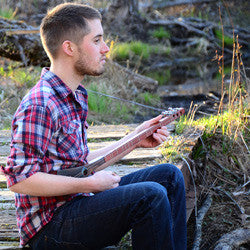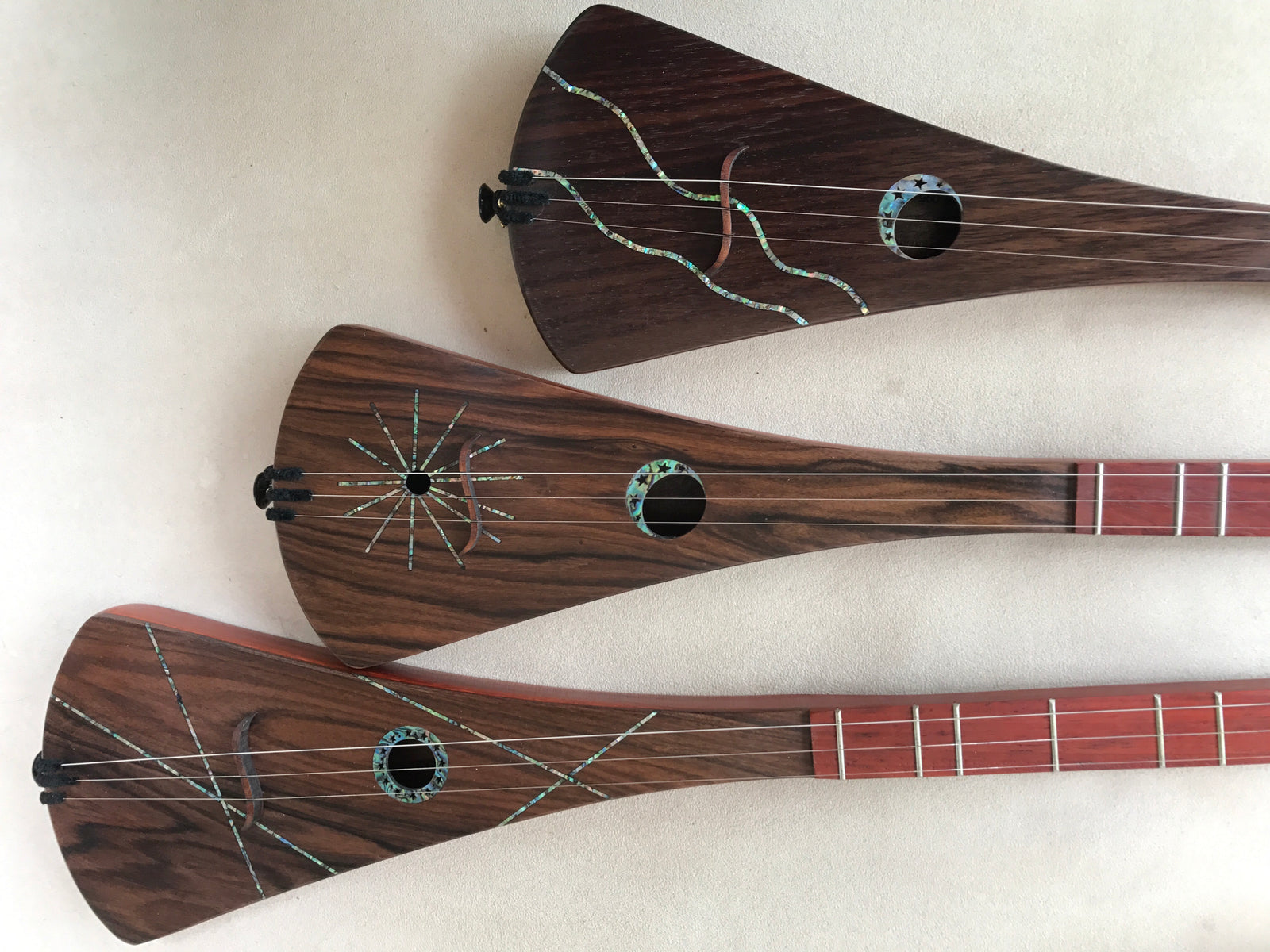Learning Guitar with the Strumstick
(The Strumstick as a Pre-Guitar Trainer). How you can use the Strumstick to learn guitar faster.
Introduction
Before I designed the Strumstick, I taught guitar for many years. I had a first hand appreciation of the difficulties beginning guitar players suffer. I took what is difficult about guitar and what frustrates people the most, and designed the Strumstick to eliminate those things. The Strumstick has proved to be very successful at giving beginning musicians an easy entry into playing music, and its simplicity has makes it a valuable tool for experienced musicians looking for a path back to the inspirational beauties of simple music. That was as I planned and hoped, as I designed it.
But the Strumstick has another useful aspect that I did not specifically think about at the beginning. The Strumstick makes a terrific trainer for people learning guitar. This article will explain why that is. It will show you how to learn guitar faster and with less frustration using a Strumstick before or during your guitar learning period.
We will look at:
• The way many people learn guitar and what they find frustrating.
• How the Strumstick can help with those areas that are frustrating.
• Why having fun is so important to learning.
• How to use the Strumstick to succeed at learning guitar.
I have taught hundreds of people to play guitar, and thousands how to play Strumstick. You will find this information helpful in learning guitar, whether you use a Strumstick for assistance or not. Whether you are taking lessons or are teaching yourself, whether you are are learning rock, folk, or classical, what we will talk about should be helpful to your learning process.
Why is Guitar so hard?
The Guitar is an amazingly versatile instrument. That is why guitar is hard at the beginning. It is not designed to be simple, to make life easy for beginners; it is designed to be complex, to be a really versatile tool in the hands of an expert. When you start to learn guitar, half the battle is avoiding notes you do not need now. You are learning on the same instrument that Eric Clapton performs on. By the way, Eric encountered the same difficulties learning that you will encounter, and was just as frustrated (in fact he quit for a year when he first started..
Most people start Guitar learning chords, and it takes typically 4-5 months It takes months for this situation to improve to the point where you start to like what you are playing, and start to say “hey, I think this is starting to work.” Many people get frustrated with their seeming lack of ability after a month or two and quit, thinking “I do just not have what it takes”
The first months of guitar are spent doing two kinds of things.
The first thing has to do with your hands. You are trying to get them to do things they have never done before. They may not be strong enough, coordinated enough, and flexible enough to do the things you are asking them to do. That is why you get muffled notes, buzzes, missed strings, and you feel rather helpless and hopeless when you start on the guitar. .
The second thing has to do with your brain. You are trying to memorize a whole series of chord fingerings, all of which rather blur together as you try to learn them. You are also learning things to do with the right hand....strumming rhythms, or fingerpicking patterns, or lead lines of one note after the other. All of this takes mental concentration, mental energy. Many people feel it all seems too confusing at the beginning. Well, it is!
There just is not enough brain power to go around, it seems. To make matters worse, the two kinds of things you are doing interfere with each other. The mental attention you have, which is barely sufficient for remembering which finger goes where, it being distracted by the need to actually move your fingers to the places you dimly remember they have to go to.
How Can the Strumstick Help?
The Strumstick can help with both hands and brain. The physical kinds of things you are doing with your fingers are very similar on guitar and on Strumstick. Positioning fingers, squeezing the strings, using different fingers, and strumming are all common activities on both guitar and on Strumstick. The specific positions may be different, but you are doing the work of positioning in both cases. Quick Strumstick Demo video
The big difference is that with the Strumstick, you are doing these things in small amounts, and are getting a good sound in reward for doing them. You can engage your brain, think about and control what you are doing more easily, because you are not overloaded with just trying to make your hands work. That leads to satisfaction and progress with both hands and brain. Learning Guitar, you are doing more than you can manage, and you are getting unsatisfying sounds to boot. That leads to frustration and all too often, to quitting.
With the Strumstick, you are getting exactly the basic training your fingers need to play guitar, but are having fun while you are doing it.
Quitting Guitar
Almost always, people say they quit because it was too frustrating, and because they became convinced that they never would succeed. They also say that they quit between 2 and 5 months into learning. Some people quit at 3 months, start up a year later, quit at 3 months, start up a year later, and quit again at 3 months.
The terrible irony of all this is: the people who continue on with guitar, and become competent enough players to actually enjoy playing from then on, are not doing any better at 2-4 months than the people who quit! They are just not as frustrated about how (bad) they are doing. The people with the highest expectations, the most lofty desires for their playing are those that quit first! You could really say that the people with the best taste are likely to quit sooner. That is not fair...the people who want it the most are the most at risk of quitting!
Help, Frustration, and Realistic Goals
Fortunately, there are a number of very useful things that can be done to reduce your frustration while learning guitar. Some of them involve just you and your guitar, and some of them involve using the Strumstick. Some of these things are things that good guitar teachers know, and communicate, but many teachers do not concentrate on reducing frustration, rather they concentrate on improving playing itself....that can be exactly the worst thing for an already frustrated player. The best teachers know that motivating their students to continue is a key part of their job. Not all students have the best teachers, and many do not have any teacher! And even the best teachers have not usually studied the sources of frustration and worked out methods to deal with them.
The single most important thing is that you keep playing. If you keep playing, you can’t help but learn to play well eventually. If you stop playing, the contest is over. BUT: many people will not persist with an effort that gives them no reward after 3 or 4 months. So anything that makes playing more fun, less frustrating, and more rewarding is a big plus towards learning guitar. That is where the Strumstick comes in. Not only does it give you a non-frustrating training ground on which to “build up your guitar muscles”, it also gives you a lot of musical satisfaction and accomplishment all by itself. That can make a huge difference in your outlook when guitar gets tough. The fact that you can already play some nice stuff on Strumstick can keep you from saying “ I am just not cut out for this”. Playing Strumstick not only makes it easier to learn guitar physically, but it also reduces your frustration, and even makes you more patient with the various difficulties you will encounter with guitar. Frustration is a key element in succeeding or quitting Guitar, let’s take a look at it.
How to Use The Strumstick as a Pre-Guitar Trainer
You start playing the strumstick by fingering just the first string, with just one finger, and strumming all three. A really nice sound happens, and it is a full kind of sound, because the other two strings are sounding too, but you are not having to finger them. Your right hand is strumming all three strings, which is actually easier than trying to play just one string. The amount of mental energy and concentration you are expending is low, and the amount of physical effort you are expending is minimal (squeezing with your left hand, and strumming all three with your right. You are getting a good sound, with a low outlay of both mental and physical energy. Strumstick Demo Video again...
Your Frustration factor is very low, and your success rate is high. Your finger (just one of them) is going to get stronger as you continue playing. Over some time, you can try using a different finger, so that can get some exercise and strengthening. You are developing strength and coordination in a non frustrating environment, and you are very likely to continue because you are having fun doing it.
A detailed instruction manual and Instruction CD come with your Strumstick, supplemented by a host of instruction videos on strumstick.com. They show you how to hold the Strumstick, how to strum, how to finger it, how to adjust the strap, hold the pick, all that stuff. The skills you will want to develop for learning guitar are the same as for starting Strumstick, at first.
Strumstick Techniques as Pre-Guitar Trainer...I would suggest using the order listed below (read each specific topic in the instruction book before you try these).
1. Fingering one string at a time but strumming all three, while making random changes of fret position with the left hand. Basic Fretting Video
2. Working with downstrums only; Strumming Basic Video (first part)
3. Adding upstrums; Rhythms Video
4. Developing free strumming (that is making up changing rhythms as you go along), Continue with Rhythms Video
5. Tuning the strumstick Tuning Instructions page
6. Starting to play songs (See the instructions for this at the back of the instruction book). Notice that this will be the first time we are really getting specific about which note gets fingered when. We have saved the mental organization step until you have some physical “chops” well underway.
7. Working different rhythms into the songs.
8. Learn some MiniChord fingerings (these are easy two finger moving harmonies) MiniChords Part 1 video (see Part 2 and Part 3 also)
9. At some point along the way, you will want to start to use different fingers for fingering songs or for making up melodies, if you have not started doing that yet. This is a topic NOT directly covered in the instructions, so I will say a few things about it here.
9 A. It does not matter which finger does which note on which string. EXCEPT: since you are coming from some note before the current one, and going to some note after the current one, use your common sense. Experiment with different finger combinations that make it easier rather than harder to play several notes in a row.
In general, you can handle three adjacent frets with three adjacent fingers, without moving your hand up or down the neck very much. Start to incorporate your 2nd, 3rd, and even your 4th fingers into your playing, so you will start to develop strength and dexterity in all of them. You can use the 4th (pinky) finger as an alternate for the 3rd if you like.
You may feel clumsy again at first, as you employ previously unused fingers. Be patient and take your time. Notice that we have said nothing about Full Chords yet. It is really good to get used to playing melodies using all three fingers and MiniChords BEFORE you start to work on Full Chords.
9 B. Now look at and try out the various full strumstick chord fingerings in the back of the booklet (and on the web site or in the back of the songbook). Experiment with what combination of fingers feels most comfortable to you. take your time and try each chord out to see what feels comfortable and what feels uncomfortable. After you have started to work with the strumstick chords (which are easier than guitar chords) you are ready to be thinking about working with guitar.
10. Fancy techniques, like hammering on, pulling off, and sliding are great on strumstick, and transfer pretty directly to guitar. The same is true of adding accents to strumming, and all of the Strumstick Rhythm effects. See the videos for all of these...
Strumstick and Reducing the Frustration Factor
Frustration happens when your expectations run into reality that is quite different from your expectations. If it took you a year to learn to play guitar at a basic level, but you loved every minute of it, you would not care that it took you a year. Most people start learning guitar at a pace that will make them play at the basic level in about 8 months, but half of them get frustrated at three months, and quit. That illustrates how poisonous frustration can be.
Think about Frustration as if it were a toxic substance. You are trying to reduce your exposure to it. Measure your progress toward guitar playing by just two factors:
1. How much time you have spent playing, and
2. How much are you enjoying it/ how little are you frustrated.
Do NOT measure your progress by how fast you are playing, or how good you sound, or even by how impressed your friends are!
You will NOT play guitar fast, and you will not sound good, in the first months, and unless you shift your expectations, you will not have much fun either. So those measures will only make you frustrated. If you are steadily playing your way forward, week after week, and are keeping your enjoyment high (or at least your frustration low), it is virtually a certainty that you will succeed in learning Guitar.
Using the Strumstick reduces Guitar Frustration Three Critical Ways:
Firstly, your fingers get stronger and more nimble on the strumstick so you are preparing for guitar without exposing yourself to so much toxic frustration. When you do work on the guitar, your fingers are more ready so you actually play less poorly than you would have, so you do not get as frustrated.
Secondly when you play the Strumstick you are having fun. Fun is the antidote to toxic frustration. Fun dissolves frustration like salt melts ice. So the fun you have playing the Strumstick makes you more tolerant of the difficulties you’ll face on guitar, even as it makes those difficulties less. That’s a good deal!
Thirdly, the fact that you can sound good on the Strumstick is a huge morale booster, it helps you recognize that it is a matter of time with guitar, not a matter of “some people got it and some people don’t, and I don’t!”
To repeat: Frustration happens when your expectations are not met; Frustration is the biggest difficulty you are going to meet playing guitar; Measure your progress ONLY by how much time you have spent playing, and by how well you are doing keeping frustration at bay.
That is all you need to do to succeed. The Strumstick helps both your actual guitar performance in the early stages, and your tolerance for frustration.
When should you start working with Guitar?
You have two choices;
Either work on Strumstick alone before you start working on guitar, or
Work on them both together.
I think your best results will come from working on strumstick alone, at least for a few weeks, or even a couple of months, but that depends on you. Remember what you are trying to accomplish by using the Strumstick to help you learn Guitar. The Strumstick gets a lot of mileage out of one finger, but guitar really needs three or even four most of the time. So you will get the most benefit from strumstick if you play it long enough to get up to where you are using at least three fingers without too much difficulty. Keep in mind that part of the plan is to avoid and reduce frustration. The Strumstick is inherently easy, and non-frustrating, but it will still take some time to get all three fingers working. Start with one, work up to three.That would the benchmark for when it would make the most sense to shift to Guitar, or to add guitar in while still playing Strumstick.
You are also getting used to Strumming with your right hand. That skill will develop faster than the left hand skills, but you should work through the information on strumming and especially on free strumming in the instruction materials. Guitar needs a larger motion from your strumming hand (more strings to cover). This is worth paying attention to, and working on when you move to Guitar.
The most important thing you are getting out of the Strumstick is satisfaction, enjoyment, and pleasure at the sounds you are making. When you shift to guitar, the sounds will not be as rewarding for your efforts as playing the Strumstick was. You will be doing way better on guitar than you would have without the Strumstick, but you are still going to have “some dues to pay” It is very important that you expect that, and don’t let that throw you. You have gotten a lot of satisfaction (I hope!) out of playing the Strumstick; you have built up a reservoir of “hey, I can do musical stuff”. Now when you work on guitar, let that confidence and enjoyment reassure you... you will get better at guitar, just like you got better at Strumstick. It may take longer, and it will likely be more work making progress on guitar, so be patient, and don’t be hard on yourself. Self-criticism is probably the single biggest source of frustration (remember Toxic Frustration!) when learning guitar. Remember: you can always put the guitar down for a minute or an hour or a day or two, and “refresh” yourself with some fun music on the Strumstick. That is why I recommend cross training: strumstick alone for a while, and then guitar, while still playing with the strumstick as you go along, especially when it gets frustrating.
A good teacher can help a lot. A good teacher is not the best guitar player you know; a good teacher is someone who understands what it is like to be learning, who knows how destructive frustration can be, and who can explain guitar things to you in a way that makes sense to you. All teachers are not for all students. Look for a teacher who feels like fun, who will teach you the style of guitar you are interested in playing, and who seems to have a knack for pointing out little things that you overlook (like subtle positioning of your hand) that can make learning easier.
This covers the basic concepts and techniques for using the Strumstick to help you learn Guitar. Please be assured that the strength, coordination, and satisfaction you developed using the Strumstick are a tremendous boost towards your goal of becoming an accomplished guitar player. Best of Luck!






Leave a comment (all fields required)